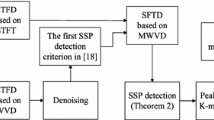Abstract
As the problem of array mixing model of wideband signals cannot be solved by conventional blind source separation algorithms, an improved algorithm based on beamforming is proposed in this paper. First, the received signals are transformed into time–frequency domain, and the delays of source signals are estimated. Then, the received signals are compensated with the estimated delay in frequency domain. Finally, the desired signal is acquired by using Frost wideband beamforming algorithm. Due to adopting the new methods of single source point extraction and delay estimation, the complexity of the proposed algorithm is reduced. Pre-steering delay is used in frequency domain to eliminate the compensation error when the delay is not an integer multiple of the sampling interval, which improves the separation performance significantly. The simulation results show that the proposed algorithm can adequately solve the problem of delay mismatch and achieve wideband blind source separation effectively. The existing algorithms are mostly fail for frequency hopping signals when there are numerous overlapping time–frequency points. In this case, the proposed algorithm still has good separation performance.











Similar content being viewed by others
References
Wang, Y., & Chen, L. (2003). Wideband blind beamforming and blind separation of convolved mixtures. Technical Acoustics, 22(1), 40–43.
Nguyen, L. H., & Tran, T. D. (2017). Interference separation for UWB radar signals from entropy-driven robust PCA. IEEE Radar Conference, 2017, 0389–0393.
Li, M. L., Bi, D. P., & Chen, L. (2017). Wideband source separation algorithm based on frequency invariable transformation. Journal of Detection and Control, 39(3), 75–80.
Liu, X. H., Luo, J. Q., & Liu, X. (2014). Multi-wideband jamming signals identification method and separation algorithm in frequency domain. Aerospace Electronic Warfare, 30(5), 36–39.
Xiong, K. L., Liu, Z., & Jiang, W. L. (2014). Broadband blind source separation algorithm based on array model. Systems Engineering and Electronics, 36(4), 613–618.
Xiong, K. L., Liu, M. Z., Liu, Z., et al. (2015). Broadband DOA estimation and blind source separation based on EM algorithm. Acta Electronica Sinica, 43(10), 2028–2033.
Bhotto, M. Z. A., & Bajić, I. V. (2015). Constant modulus blind adaptive beamforming based on unscented Kalman filtering. IEEE Signal Processing Letters, 22(4), 474–478.
Faller, K. J., Riddley, J., Grubbs, E. (2017). Automatic blind source separation of speech sources in an auditory scene. In 2017 51st Asilomar Conference on Signals, Systems, and Computers, Pacific Grove (pp. 248–250).
Asaei, A., Bourlard, H., Taghizadeh, M. J., et al. (2016). Computational methods for underdetermined convolutive speech localization and separation via model-based sparse component analysis. Speech Communication, 76, 201–217.
Cong, W., Yang, L., Sun, C., Yang, R., Zhu, S. (2018). Blind source separation and equalization for high order QAM signals in MIMO system. In 2018 10th International conference on intelligent human-machine systems and cybernetics (IHMSC) Hangzhou (pp. 52–55).
Papadias, C. B., & Paulraj, A. J. (1997). A consta nt modulus algorithm for multiuser signal separation in presence of delay spread using antenna arrays. IEEE Signal Processing Letter, 4(6), 178–181.
Kung, Y. (1998). Blind beamforming on a randomly distributed sensor array system. IEEE Journal on Selected Areas in Communications, 16(8), 1555–1567.
Liu, Y. Q. (2015). Research on blind beamforming algorithm based on time-frequency analysis (pp. 39–49). Information Engineering University.
Xu, S., Liu, Y. L., Chen, S. R., et al. (2008). A time-domain algorithm for blind source separation of non-stationary convolutive mixtures. Journal of Electronics and Information Technology, 30(3), 589–592.
Zhao, Y. J., Chen, H., Liu, C. C., et al. (2014). Research on structure and algorithm of wideband beamforming. Journal of Electronic Measurement and Instrumentation, 7, 687–694.
Acknowledgements
We gratefully acknowledge anonymous reviewers who read drafts and made many helpful suggestions. This work is supported by National Nature Science Foundation of China (61201134).
Author information
Authors and Affiliations
Corresponding author
Additional information
Publisher's Note
Springer Nature remains neutral with regard to jurisdictional claims in published maps and institutional affiliations.
Rights and permissions
About this article
Cite this article
Fu, W., Zhang, Y. Wideband Blind Source Separation Algorithm Based on Beamforming. Wireless Pers Commun 108, 221–234 (2019). https://doi.org/10.1007/s11277-019-06398-8
Published:
Issue Date:
DOI: https://doi.org/10.1007/s11277-019-06398-8




